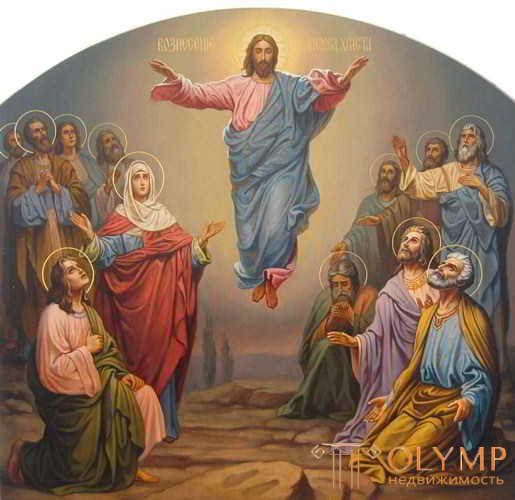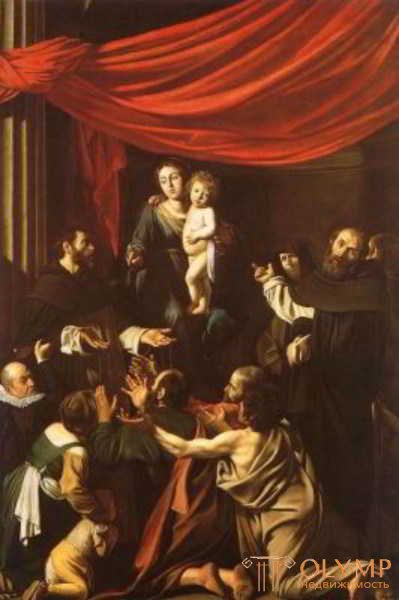
1. Art of Sicily and Southern Italy
The magnificent earths of Southern Italy and Sicily warmed by the heavenly and underground fire in the 16th century, under the rule of the Spanish governors, took only a small part in the powerful artistic movement that carried Europe, starting with the rest of Italy.
Regarding the architecture of high and late Renaissance in Sicily, nothing says even di Marzo, the historian of Sicilian art. Only in southern Italy can only be noted individual buildings of this century. Aquila, a cool town in Abruzzi, had just become Spanish when Cola dell Amatrice performed for the church of San Bernardino (1527) the facade of the early Michelangelo style. Naples was already accustomed to the Spanish domination, when here (in 1516) the church of San Giovanni and Carbonara received its round Caraccioli chapel dissected inside by Doric pilasters. A little later (1517–1524), the single-nave church of Santa Maria delle Grazie appeared here, covered with a flat roof, animated by “triumphal-like entrances to the chapels” (Burkgardt). Then we can again be pleased with the Jesu Nuovo church (1584), built by Pietro Provedo in the style of a noble late Renaissance, in which, together with Gurlitt, we see the central building in the style of Tibaldi, elongated in the spirit of the Roman Jesuit church of Vignola. A little later (in 1592) Dionisio di Bartolommeo built the original cruciform basilica with the columns of San Filippo Neri in Naples, with a longitudinal body divided by twelve porphyry columns into three naves. The Lombardian Domenico Fontana opened the new century here with his new prosaic royal palace.
In architecture, and only for it, throughout the XVI century in Sicily and in Naples, the main role is played by decorative marble plastics, along with which there was no independent sculpture here. In Sicilian decorative sculpture still dominated Gadzhini. The descendants and followers of Antonello Gagini (1478 to 1538), whose names are not the place, as well as their works, moving from one city to another, for a whole century filled the Sicilian churches outside and inside with their not particularly deep, but attractive sculptural works, but here, too, the movements gradually fell into computation. In Naples, the sculptor Giovanni Merliano from Nola (1478–1558), whose art was studied by Fritzzoni, now played the same role with his students and followers, and the best of them, Giovanni Domenico d'Auria, that Gagini in Palermo. The main work of this school is the exquisitely made decoration of the aforementioned Capella Caraccioli with numerous sculptures of round plastics and half-reliefs. Of the altars of Nola, the most famous is the altar of the Madonna in San Domenico, made in quiet forms, but imbued with internal revival, and from the gravestone monuments the mannered, but strong in execution monument of the vicar Pedro de Toledo in San Girolamo degli Spagnoli. With his rival Girolamo di Santa Croce (1502–1537), Nola competed in Santa Maria delle Grazie, where each of them performed an altar and several reliefs, without significant differences in style between them.
If this decorative sculpture of Sicily and Naples can still be considered an artistic product of the local soil, then painting can put next to it only very little, its local. Everything that could be extracted from the book The Messinian Painters and the great work of di Marzo on Sicilian painting, cleared of the slags of poorly understood local patriotism, was scientifically processed by Janíček, and in recent times for Palermo again di Marzo. It stands out only the personality of Vincenzo di Pavia, nicknamed Romano (died in 1557), who earlier mistakenly bore the name Vincenzo Ainemolo. Under this name, Janichek spoke at length about him, while di Marzo, who established his real name, promises a new work about him. Vincenzo Romano, who had worked in Palermo since 1518, is a resolute Raphaelist, although he cannot be counted among the disciples of Raphael. Anyway, he received training on the mainland. His paintings in Palermo, such as “Carrying the Cross” (1530), “Ascension of the Lord” (1533) in Pinacoteca, “Madonna del Rosario” (1540) in San Domenico, show a gradual increase in individual traits within the traditional Rafael direction, held here until the end of the century by his disciples and followers, of which it should be noted Antonio Spatafora.

Fig. 58. The Ascension of the Lord (1533) in the Pinakothek

Fig. 59. Madonna del Rosario (1540)
Distinguishing the followers of Andrea and Polidoro in Naples is not particularly difficult, but for us it is useless. It is remarkable, however, that on the transition to a new century, the close compatriot Polidoro, the great Michelangelo da Caravaggio (1569–1609) also brought to Naples his realism, imbued with new quests, developed by him already in Rome.
1. National Aspects of Italian Art
The classical Italian art of the heyday of the 16th century was undoubtedly a national art. Even its ancient components came out literally from Italian soil, and the rest consisted of traits borrowed from the Italian population, the Italian landscape, from Italian folk beliefs and Italian folk spirit. The development of art in certain regions of Italy quickly gained general artistic significance for the whole of Italy. Vasari could prefer the Florentines, Pietro Aretino and Ludovico Dolci could glorify the Venetians, Lomazzo could extol Milanese to the skies, but in the artistic consciousness of the people great artists lived for the whole of Italy. If one or other of the great masters created works of art for the extreme north or extreme south of Italy, others, creating and teaching, themselves carried their art from one place to another. At the same time, the actual mixing of local styles took place, however, only within certain limits and, moreover, not always to the benefit of art. Since the art of each region had its own roots, the art of all Italy was national, and it was the most subjective of the great Italian masters, like Michelangelo and Correggio, that could not appear on any other soil than Italian.
Blinded and enthusiastic, other nations looked at the light of the new, classic Italian national art. If by classical we mean the generally accepted and eternal, then the question is how much the art of one nation can be classic for all nations. I spoke about this in another place. On Italian soil, neither Bordeaux nor Rhine wine. Northern soil does not give neither kianti nor falernskogo. Of course, people can mutually use their works. But there is no doubt that the situation with transplanting is somewhat different. Only in cases where someone else's soil is suitable for an alien plant, will succeed. The universality of classical Italian art is primarily in the enjoyment that accompanies its perception, and not in the creative reworking of it by otherwise gifted peoples who have their own national art. Blinded and enthusiastic, other nations did not immediately recognize the boundaries within which they could assimilate classical Italian art, and the instructive struggle for this assimilation fills a considerable part of the history of 16th century art of other peoples.
Что бы оставить комментарий войдите
Комментарии (0)